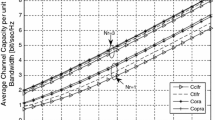Abstract
In this paper, we deal with the design of a full-rate space-time block coding (STBC) scheme optimized for linear iterative decoding over fast fading multiple-input multiple-output (MIMO) channel. A general and simple coding scheme called diagonal threaded space-time (DTST) code is presented for an arbitrary number of transmit and receive antennas. Theoretical analysis shows that DTST code associated with linear iterative decoding tends towards full diversity performance while providing maximum MIMO multiplexing gain. Simulation results confirm the ability of DTST to outperform the state-of-the-art STBC and conventional spatial data multiplexing schemes under iterative processing.






Similar content being viewed by others
References
Gesbert D, Shafi M, Shiu D, Smith P (2003) From theory to practice: an overview of space-time coded mimo wireless systems. IEEE J Sel Areas Commun 21(3):281–302
Paulraj A, Gore AD, Nabar RU, Boelcskei H (2004) An overview of MIMO communications: a key to gigabit wireless. Proc IEEE 92(2):198–218
Telatar E (1995) Capacity of multiantenna Gaussian channel Bell Labs, Technical Memo
Tarokh V, Jafarkhani H, Calderbank A (1999) Space-time block codes from orthogonal designs. IEEE Trans Inf Theory 45(5):1456–1467
Tonello AM (2000) Space-time bit-interleaved coded modulation over frequency selective fading channels with iterative decoding. In: Global Telecommunications Conference, 2000. GLOBECOM ’00. IEEE, vol 3, pp 1616–1620. doi:10.1109/GLOCOM.2000.891911
Damen M, Beaulieu N (2003) On diagonal algebraic space-time block codes. IEEE Trans Commun 51(6):911–919
Gamal HE, Damen M (2003) Universal space-time coding. IEEE Trans Inf Theory 49(5):1097–1119. doi:10.1109/TIT.2003.810644
Belfiore JC, Rekaya G, Viterbo E (2005) The golden code: a 2 × 2 full-rate space-time code with nonvanishing determinants. IEEE Trans Inf Theory 51(4):1432–1436
Oggier F, Rekaya G, Belfiore JC, Viterbo E (2006) Perfect space-time block codes. IEEE Trans Inf Theory 52(9):3885–3902
Biglieri E, Hong Y, Viterbo E (2009) On fast-decodable spacetime block codes. IEEE Trans Inf Theory 55(2):524–530
Basar E, Aygolu U (2009) High-rate full-diversity space-time block codes for three and four transmit antennas. IET Communications 3(8):1371–1378
Hassibi B, Hochwald BM (2002) High-rate codes that are linear in space and time. IEEE Trans Inf Theory 48(7):1804–1824
Reynolds D, Wang X (2001) Low-complexity turbo-equalization for diversity channels. Signal Process 81(5):889–995
Tuechler M, Singer AC, Koetter R (2002) Minimum mean squared error equalization using a priori information. IEEE Trans Signal Process 50(3):673–683
Laot C, Le Bidan R, Leroux D (2005) Low-complexity MMSE turbo equalization: a possible solution for EDGE. IEEE Trans Wirel Commun 4(3):965–974
Le Josse N, Laot C, Amis K (2006) Performance validation for MMSE turbo equalization in ST-BICM systems. In: IEEE 64th vehicular technology conference. VTC-2006, p 1–5
Bouvet PJ, Helard M, Le Nir V (2006) Simple iterative receivers for LP-OFDM MIMO systems. Ann Telecommun 61(5):578–601
Boher L, Rabineau R, Helard M (2008) FPGA implementation of an iterative receiver for MIMO-OFDM systems. IEEE J Sel Areas Commun 26(6):857–866
Proakis JG (1995) Digital communications. McGraw-Hill, New York
Golub G, Van Loan C (1996) Matrix computations, 3rd edn. Johns Hopkins Univ Press, Baltimore
Press WH, Flannery BP, Teukolsky SA, Vetterling WT (1992) Numerical recipes in C: the art of scientific computing, 2nd edn. Cambridge University Press, Cambridge
Visoz R, Berthet AO, Lalam M (2010) Semi-analytical performance prediction methods for iterative MMSE-IC multiuser MIMO joint decoding. IEEE Trans Commun 58(9):2576-2589
Acknowledgment
Part of this work has been carried out with the support of Orange Labs, France.
Author information
Authors and Affiliations
Corresponding author
Appendix
Appendix
Let us first derive the general expression of received sample from antenna \(j \in [1,N_{r}]\) at sampling time \(p \in [1,T]\). From (3), we can write:
Let us now consider DTST encoding as presented in Section 4. By using (32) and setting \(i=\lfloor l+p-2 \rfloor _{N_{t}}+1\), Eq. (53) may be rewritten for the DTST case as:
where:
We can see that \( [\mathbf {u}_{l}]_{p}\) is only function of \([ x_{(l-1)N_{t}+1},..,x_{(l-1)N_{t}+N_{t}}]\). In other words \([\mathbf {u}_{l}]_{p}\) is not linked to \([\mathbf {u}_{l'}]_{p}\) for \(l \neq l'\). As a result, (54) may be factorized as:
Since DTST codes are complex linear STBC, Eq. (5) can be invoked. This yields that Eq. (54) may be rewritten in the following form:
Let us write \(k=(l-1)N_{t}+n\) for \(l\in [1,L]\) and \(n \in [1,N_{t}]\). By identifying (58) and (59), we obtain:
The Euclidean norm of \(\underline {\mathbf {h}}_{k}\) for \(l\in [1,L]\) and \(n\in [1,N_{t}]\) becomes:
By construction of the precoding matrix \(\mathbf {\Theta }\), we have
On the other side, we can notice:
Finally, it yields:
Rights and permissions
About this article
Cite this article
Bouvet, PJ., Hélard, M. Optimal space-time coding under iterative processing. Ann. Telecommun. 69, 229–238 (2014). https://doi.org/10.1007/s12243-013-0353-z
Received:
Accepted:
Published:
Issue Date:
DOI: https://doi.org/10.1007/s12243-013-0353-z




